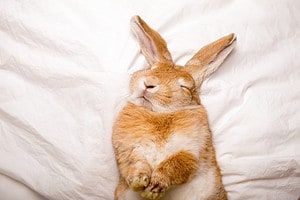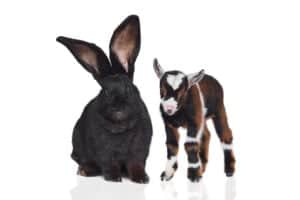The lucky rabbit’s foot has a strange but true history. In 1584, people carried a rabbit’s foot to spare themselves from arthritis and cramping. Nobody is sure why this was a popular thought, but we can piece together some of the later details to form a cohesive history of the strange but true story of the lucky rabbit’s foot.

Lucky rabbit’s feet are popular around the world.
©iStock.com/Ornitolog82
Its form today isn’t merely a superficial token of childhood, but rather the result of a complex intertwining of folk traditions from widely varying avenues. The rabbit’s foot has nothing to do with the Christian holiday of Easter despite popular belief.
Today’s rabbit’s foot is not a solely American phenomenon. Their popularization has carried through large swaths of the world and most people see them now as a simple reminder to keep standing strong, so you’ll have good luck.
So, what is the strange but true history of the lucky rabbit’s foot? It’s the opposite of lucky, which makes it lucky. Read on to find out more.
The European Middle Ages and the History of Rabbit’s Feet
Any man that was hanged was dubbed the “Hand of Glory” during the Middle Ages when executions in the street were popular. The victim’s corpses would hang in the streets to deter others from committing crimes.
A practice between these corpses and the population was that their left hands would be cut off and pickled for luck related to supernatural phenomena. This belief may have paved the way for the development of the rabbit’s foot in lore.
Gruesome actions remain associated with the rabbit’s foot throughout the rest of its history, and the history of the rabbit as a representation of evil was popular in the Middle Ages. It was seen as both the hard path to finding salvation as well as seen as a symbol of lust because of the rabbit’s breeding habits. These beliefs stem from the uncleanliness of the rabbit in the Old Testament.
That doesn’t mean that the rabbit was always seen as evil. In tales and paintings about Jesus, he is often depicted as surrounded by white rabbits. These white rabbits symbolize purity and innocence, which is quite opposite of the Old Testament interpretation.
The History of Witchcraft and the Rabbit’s Foot

A few centuries ago, rabbits were thought to be shape-shifting witches.
©iStock.com/NIKITA ARMYAGOV
A means of finding witches were associated with the rabbit’s foot, which made it a lucky kill if it happened to be a witch in disguise. In the early 1800s, witches were believed to take the form of a rabbit, so rabbits were killed so their feet could be used as talismans (or objects with magical powers). They died in a way that’s suitable for a supernatural being.
Others wanted the rabbit’s foot to be cut off while the rabbit was alive. This is so that any witch they caught would also have the injury in real life which makes them identifiable.
In the 1930s, people chased animals around purposefully to injure them if they thought there was a witch in town. In hunting animals like rabbits and cats, they thought they were doing a service to their community.
In Wales, it was believed sometime in the late 1800s to early 1900s that shooting a rabbit with a silver bullet would make a witch die wherever they were. Tales like this are also recorded in America around this timeframe.
Black History and Rabbit’s Feet
Enslaved African Americans saw rabbit’s feet as an embodiment of cleverness, though that cleverness could be good or evil. It was modeled after a popular folk tale that involved a conniving yet powerful rabbit. Due to the injustices that enslaved Americans and their freed descendants endured, the idea of cleverness, cunning, and superiority in the face of oppressive forces was a powerful message.
The point of the rabbit’s foot was not to bring general luck but was specifically meant to bring luck in defending yourself against a subversive American culture.
In the 1880s, rabbit charms were being sold across the black sections of New Orleans. They had a ritual attached to them that made the charm special which involved the moon, how the rabbit was dispatched, by whom, and making sure it was the left foot. This concept of ritual around a rabbit’s foot was also marketed to Europeans.
Commercialization of the Lucky Rabbit’s Foot

Today the lucky rabbit’s foot has lost most of its historical meaning.
©Ekaterina Glazkova/Shutterstock.com
Around 1908 rabbit’s feet were a common product in England from America. It was a popular custom in America in both black and white cultures, though there isn’t much written down about it. There are folk tales that have been written down that show that it was commonly believed by communities that the rabbit’s foot would bring good luck and money.
There was a postcard in America from 1909 with lucky objects on it. One of those objects was a rabbit’s foot, as well as a horseshoe and wishbone.
By 1932, carrying rabbit’s feet was a common occurrence in England among all classes. While it was widely accepted as an amusing object, the idea that a rabbit’s foot could convey anything deep became lost to consumers.
Is My Lucky Rabbit’s Foot Real?
Chances are any lucky rabbit’s foot purchased recently is not real. It may feel like there are bones buried in fur, but that’s just a cleverly designed product meant for mass consumption. You most likely have fake fur around either a piece of latex or leather.
Don’t Rabbits Symbolize Fertility?

Rabbits usually symbolize fertility, but the rabbit’s foot has a different history.
©iStock.com/Sasiistock
Rabbits do symbolize fertility in a lot of other situations, especially in relation to the Christian holiday of Easter. Because rabbits can breed quickly and in impressive numbers, they’re often linked to the resurrection of Christ. This has roots in pagan traditions that were adapted to Christianity and doesn’t link to the lucky rabbit’s foot historical narrative.
Why are horseshoes symbols of luck?

Horseshoes are known for good luck.
©Gabarrella fotograf/Shutterstock.com
Another great symbol of luck that goes back historically a long time, is the horseshoe, which you probably have seen nailed to a wall or a door in a home. You actually may have seen them hung in either direction: facing up or facing down. Some claim that you would want the horseshoe facing up in order to catch luck and fill up as a basin, and others claim that you would want to the horseshoe to be facing down in order to pour out luck onto the home.
Traditionally, they would have seven nail holes and be made of iron. The number seven is seen as a powerful number in Christianity and iron was known to ward off or harm fey creatures and other supernatural elements.
In lore, the Archbishop of Canterbury tricked the devil and nailed a horseshoe to his foot. He agreed to remove it if the devil would not enter a home that displayed a horseshoe.
The photo featured at the top of this post is © Ekaterina Glazkova/Shutterstock.com
Thank you for reading! Have some feedback for us? Contact the AZ Animals editorial team.






